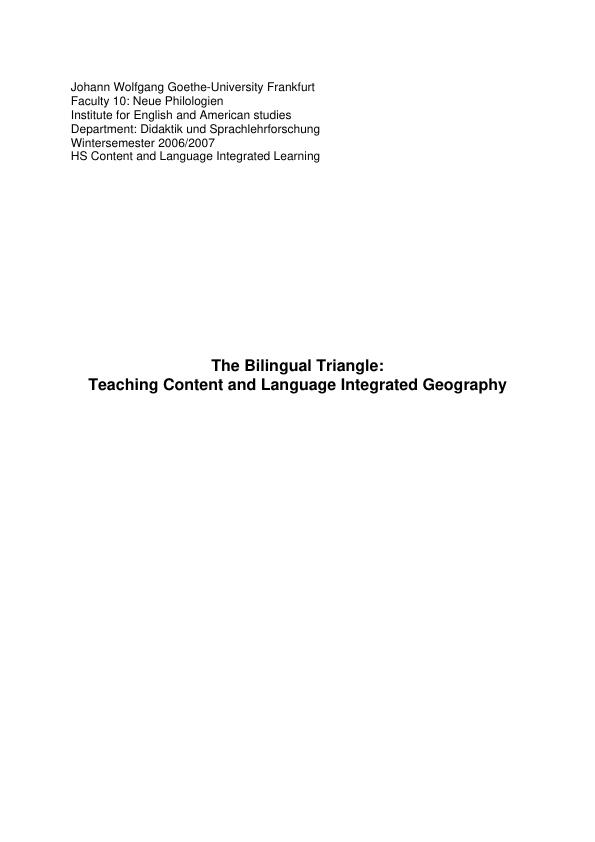1 Introduction
The focus of this term paper is a presentation of a draft for a bilingual Geography study unit on “migration”. Firstly, the paper describes general didactic principles of bilingual teaching and furthermore exemplifies aspects of creating a bilingual teach-ing curriculum and of bilingual teaching in the geographical context in general. More-over, it adapts the curriculum for Georgraphy in Hesse for the study unit. The study unit contains five lessons that respectively emphasise one of the three aspects of the Bilingual Triangle by Hallet.
2 Didactic concepts
This chapter gives an overview of didactic concepts for teaching a subject bilingually at school. The fist concept referred to describes bilingual teaching principles more generally in terms of connecting the subject and the foreign-language teaching. The second concept “The Bilingual Triangle” is a more concrete theoretical basis espe-cially for teaching bilingual subjects among Humanities such as Geography, Politics or History.
2.1 Connecting models
In Germany there are 3 connecting models to describe bilingual teaching principles. The first model – the Linear Model – describes that the foreign language should pre-pare bilingual subject teaching and that there should be a degree from foreign-language to bilingual subject teaching. But there is no inner connection between for-eign-language teaching and subject teaching.
The second Parallel Model deals with a connection of the two subjects. This connec-tion is continual and the aim is to connect aims and tasks of foreign-language teach-ing and subject teaching.
The third model is the Integrative Model. It means that teaching is content and lan-guage integrated, i.e. teaching the subject in integration with foreign language. The aim is the instrumentalisation of a foreign language by a subject. In Germany, the third model is the ideal type of bilingual subject teaching and it should be every bilin-gual teacher’s aim. But on the contrary, just the first type is often realized because of the teacher being insecure in teaching methods, a non-standardized education pol-icy, lack of materials and the teacher’s bad education.
Inhaltsverzeichnis (Table of Contents)
- Introduction
- Didactic concepts
- Connecting models
- The Bilingual Triangle
- Teaching Geography
- Curricular framework for bilingual Geography
- Implementation of the Bilingual Triangle in Geography
- Migration - one aspect in the Hessian Curriculum for Geography at Gymnasien
- Draft of a bilingual Geography lesson
- Own country and culture
- Other countries and cultures
- Intercommunity
- Didactic reasoning
- Conclusion
Zielsetzung und Themenschwerpunkte (Objectives and Key Themes)
This paper presents a draft for a bilingual Geography study unit on "migration". It aims to describe general didactic principles of bilingual teaching and provide practical examples of creating a bilingual teaching curriculum for Geography. The paper focuses on adapting the Geography curriculum for Hesse to incorporate the study unit.
- Didactic concepts for bilingual teaching in general.
- The Bilingual Triangle as a theoretical framework for bilingual subject teaching, particularly in the Humanities.
- Applying the Bilingual Triangle to the teaching of Geography.
- Developing a curricular framework for bilingual Geography teaching.
- Implementing the Bilingual Triangle through a specific study unit on migration.
Zusammenfassung der Kapitel (Chapter Summaries)
The first chapter introduces the study unit on "migration" and its focus on bilingual Geography teaching. It outlines the paper's objectives, including presenting general didactic principles and providing a practical example of curriculum development. Chapter two presents an overview of didactic concepts for bilingual subject teaching, exploring three connecting models (Linear, Parallel, and Integrative) and the theoretical framework of the Bilingual Triangle. Chapter three focuses on teaching principles for bilingual Geography, particularly the construction of a curricular framework and specific facets of Geography within a bilingual classroom context.
Schlüsselwörter (Keywords)
Bilingual teaching, content and language integrated learning (CLIL), Geography, curriculum development, Bilingual Triangle, migration, intercultural teaching and competence, own country and culture, other countries and cultures, intercommunity.
- Quote paper
- Evelyn Schmitz (Author), 2007, The bilingual triangle: Teaching content and language integrated geography, Munich, GRIN Verlag, https://www.grin.com/document/87505




